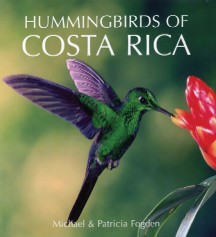Reviewed by Grant McCreary on February 7th, 2007.
There have been many books dedicated to the hummingbird family. In order for any new ones to be worthwhile they need to either cover new ground, or tackle an existing subject better than previous works. Additionally, exceptional illustrations are required. This book meets both criteria by focusing on a specific country other than the United States and Canada, and by featuring fantastic photography.
All 45 resident hummingbirds of Costa Rica are covered here, with all but one represented with photographs. The lone absentee is the Plain-capped Starthroat which the authors have not encountered low enough to photograph. The other hummingbirds that have been recorded in Costa Rica but not included in this work are either migratory and present only in winter (Ruby-throated Hummingbird), or have not been recorded for many years.
Non-photographic illustrations of this family can be very useful for identification purposes. However, they do not adequately capture the subject’s beauty due to the iridescent nature of the plumage. Therefore, I prefer photographs in books such as this one. The photography here is breathtaking. The birds are portrayed in full splendor and in most cases larger than life. They are all crisp and clear. You can count the primaries on nearly every bird in-flight. Every single photograph was taken in a wild setting – there is not a single feeder or other man-made object shown. Most of the birds are shown at flowers. The bird-flower relationship is very prominent in the photos and text, and every flower shown is identified.
I only wish the book could have been expanded so as to include more photographs. In many cases hummingbird identification is very difficult unless you can view it just right. From the correct angle and with the right light the bird is ablaze in color. But if not it can appear entirely dull and dark. The aim of this book is not identification, but I would have appreciated more photographs of the birds in order to capture their appearance in different situations. There are also a few sexually dimorphic species where one of the sexes is not shown.
When first looking through this book I was disappointed to see that fully half of it is an introduction to the hummingbird family. It seemed to leave too little space for the individual species accounts. But after actually reading it my disappointment faded away. The text is brief, but it still gives a good overview of this family as they are represented in Costa Rica. Topics covered include the basics such as feeding, seasonal movements, and breeding. The relationship of hummingbirds with plants and other animals is given extensive treatment. One fascinating example is the flower mites’ use of hummingbirds as a transport. They will hop on the bird’s bill as it feeds and move to the nostrils for shelter while the bird is in-flight. When the bird stops at the next appropriate flower they race back down the bill onto the flower. There is even a photograph of this where you can see the mites on the bill of a Long-tailed Hermit!
The many photos in the introduction aptly illustrate the described behavior and attributes, similar to the use of photography in the family sections in the Handbook of the Birds of the World (HBW) series. While reading this book I felt that these photographs were worthy of the HBW, which is very high praise. Little did I know that the editors of HBW must have felt the same way – many of the Fogdens’ photographs are indeed included in the hummingbird account in the fifth volume of the series.
The species accounts are very short, yet still informative. They describe the species range in the country, which plants they frequent, what feeding strategies they use, the best locations to see it, and other interesting information.
In an appendix 12 locations are given that are productive for hummingbirds. A table shows which species can be found at each of these sites.
In the end, the only criticism I have is that there were not enough photographs. Aside from the one missing species and the few forms not depicted, this is not a case where the existing pictures fail to satisfy. Quite the opposite! The pictures were so amazing that they leave you craving more! I would recommend this book to all who have visited Costa Rica, are planning on it, or who want to, along with all who love hummingbirds. Or in other words – everyone.
Disclosure: I get a small commission for purchases made through links in this post.



Comment